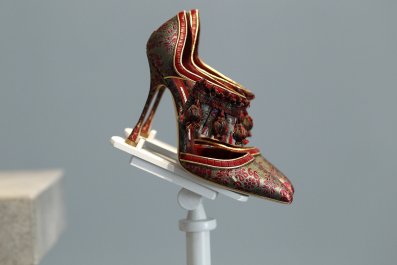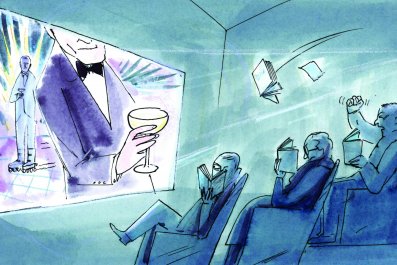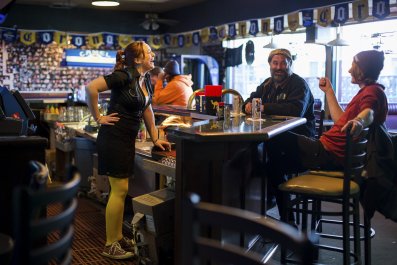Walk into any upscale market and you'll see an array of high-end chocolate bars labeled with food industry buzzwords: artisanal, small batch, fair-trade. They'll probably have slick packaging and presentation. But they're mostly a sham. Most consumers can't taste the difference between often costly fine chocolate and supermarket staples. Some believe chocolate-makers can't really differentiate between the two either.
That's why leaders in the industry have created the Heirloom Cacao Preservation (HCP) initiative. It's a joint effort between the Fine Chocolate Industry Association and the U.S. Department of Agriculture's (USDA) Agricultural Research Service, and an outgrowth of the booming artisanal chocolate business. The program is utilizing the industry's most discerning palates, along with genetic analysis, to identify—and hopefully preserve—the fine-flavored cacaos of the world. HCP's purpose is to increase the availability of quality cacao and encourage farmers to grow it in a market that's currently overwhelmed by flat-taste, high-yield varieties.
"The chocolate industry has lost sight of its fundamentals, which include flavor," says Mark Christian, founder of the C-spot, a go-to website for chocolatiers and passionate connoisseurs, who is involved in the initiative. "Most chocolate people don't know good chocolate."
Founded in 2011, HCP has so far designated seven "heirloom" cacaos in the world, with provenances in Belize, Costa Rica, Hawaii, Bolivia and Ecuador. The panel of tasting judges is made up of prominent figures in the chocolate industry, including executives from Guittard Chocolate, Scharffen Berger and Valrhona. They review the historical, cultural, botanical and geographical makeup of each cacao. But most importantly, they are adding one last innovative metric: genetic profiling. "We're going to enter the next wave of chocolate," says Christian. "Chocolate has yet to be data-driven."
Actually, corporate chocolate giants such as Lindt, Hershey's and Mars have long had an interest in genetics—but mostly as a tool for preserving and propagating cacao beans that consistently provide the highest yield and can withstand drought and diseases. And the USDA's Agricultural Research Service, the Cocoa Research Center in Trinidad and the International Cocoa Collection of the Tropical Agricultural Research and Higher Education Center in Turrialba, Costa Rica, all have ongoing programs to analyze and catalogue general data on cacao genetics. But the HCP endeavor is a completely different type of project, one that prizes quality over quantity. It's the first systematic effort by the chocolate industry to look at genetics in terms of flavor.
Historically, when the industry identified a tree with a high bean yield, cacao farmers would propagate that variety by taking cuttings of a mother tree and grafting them onto a less desirable type of cacao tree, a process known as cloning. For example, a high-yield bean might be grafted onto the rootstock of a more disease-resistant tree, creating a variety that could more effectively keep up with the industry's demands.
Two of the most popular high-volume, fast-producing varieties are CC-N51 in Ecuador and Cacao Mercedes in West Africa, which can both conceivably produce fruit in as little 18 months after being grafted. But cacao of this pedigree is generally low quality when it comes to taste and better suited for bulk production of cocoa butter and cocoa mass—critical for making Snickers but a detriment when it comes to crafting a quality bar with few ingredients.
Until recently, agronomists claimed there were only three varieties of the Theobroma cacao tree: Criollo, Forastero and Trinitario. But in 2008, Juan Carlos Motamayor, a tropical agronomist for the USDA's National Clonal Germplasm Repository and lead scientist of cocoa genetics at Mars Incorporated (makers of M&Ms, Twix, Milky Way and many other candies), published a study in the journal PLOS One that upended industry beliefs. His team conducted genetic analysis on samples from the three known species. After comparing DNA snippet patterns, they discovered 10 distinct cacao genotypes.
A few years later, most believe the number is probably much higher, says Lyndel Meinhardt, a research leader at the Agricultural Research Service's sustainable perennial crops lab. The Mars research, he says, accounted for samples from only a handful of germplasm banks and collections in the world, and didn't represent cacao genotypes still out in the wild that have yet to be discovered. Meinhardt is helping to build a genetics database of cacaos known to have the finest flavors and has already genotyped HCP's first heirloom samples. The current count is 14 types of cacao, but that number is expected to grow—the USDA continues to make efforts to locate more diverse botanicals in unexplored areas of the Amazon.
A decade ago, Volker Lehmann, a German farmer, discovered an abundance of cacao trees on several islands that speckle the Beni River, a tributary of the Madre de Dios River that flows into the Amazon. Recently, DNA analysis confirmed that this was a brand-new cacao variety. It was named Bolivia Tranquilidad and became the second cacao to earn an HCP heirloom designation, after Bolivia Alto Beni. According to HCP's tasting panel, it has a flavor profile of "floral overtones—slightly spicy, resinous with green notes…trace vanilla character…slight balsamic wood resin and aged fruit notes."
For the USDA, conducting genetic research to encourage the production of better cacao is ultimately about job creation in this country. Chocolate production still frequently requires the use of domestic products. "You make chocolate from U.S.-grown sugar, U.S.-grown milk, U.S.-grown almonds and peanuts. So by supporting the chocolate industry, we're also supporting a lot of other U.S.-grown commodities," says Meinhardt. And it does appear that the heirloom-ization of chocolate is helping both U.S. chocolatiers and the farmers from whom they source their ingredients.
Todd Masonis began making chocolate in his friend's garage in 2010, and the former Silicon Valley executive co-founded Dandelion Chocolate a few years later. He currently has 400 stores on his waitlist and is building a larger production facility so he can keep up with the demand. He's part of a burgeoning new wave of chocolate production in the U.S. that focuses on the bean and nothing else. "We only use two ingredients—beans and sugar—in our bar," says Masonis, who is also a board member of HCP. "A bar from Madagascar will be very fruity. A bar from Venezuela will be very chocolaty. Some will be nutty or floral, and you actually really can taste the difference. Whereas, industrial chocolate for a long time has been concerned solely with consistency and low cost. There's nothing wrong with that, but it's a different set of priorities."
Masonis makes one of his bars from Maya Mountain Cacao from Belize, one of two heirlooms inducted earlier this year. The Maya Mountain business, founded five years ago, is made up of a network of 309 farms in the region. MMC buys wet cacao beans from local farmers, ferments and dries the beans, and then sells them, mostly to small-batch chocolate-makers like Dandelion. The premium beans go for $5,600 per metric ton, which is approximately $2,600 more than the current world market price for cacao beans, and Maya Granit, managing director for MMC, says approximately $3,300 of the sale of each metric ton goes directly to the farmer. She believes HCP's designation put Belizean cacao on the map.
Beth Kimmerle, author of Chocolate: The Sweet History, says the HCP initiative shows that "flavor has currency again." In recent years, companies such as Dandelion and Brooklyn-based Mast Brothers have proved there is a place in the market for a gourmet bar. Kimmerle says consumers would purchase even higher-end chocolate if businesses were willing to take the risk.
Last year, the chocolate company To'ak produced a small batch of dark chocolate bars made from a rare variety of Ecuadorean heirloom cacao. Each bar came packaged in a handcrafted Spanish elm wood box with handmade tasting utensils—the idea being that handling pieces with fingers could diminish the flavor. The specialty bars, priced at $260 each, sold out immediately. It's proof positive that HCP designation may turn out to be a useful marketing tool to target passionate chocolate lovers by creating a way for both chocolate-makers and consumers to spot quality in the product, much like the wine industry's appellation system.
"You don't have to be a sommelier to gain some knowledge about wine now," says Kimmerle. "I think when you start connecting the dots for consumers and you explain what goes into an $8 or $10 bar of chocolate, they'll probably look at you and say, 'I'm not paying enough.'"





















